
Improvement of analysis of seasonal change of danger risk with consideration of the effect of solar cycle.
 Olena Ismailova 1,
Olena Ismailova 1, Olena Voloshkina 2*
Olena Voloshkina 2*
1Institute of Telecommunications and Global Information Space, Chokolivs'kyi Blvd 13, Kyiv, 03186, Ukraine
2Kiev National University of Construction and Architecture, Vozduhoflotsky Avenue 31, Kyiv, 03680, Ukraine
Received: 10/10/2017, Accepted: 11/30/2017, Available online: 12/28/2017.
DOI: https://doi.org/10.32557/useful-1-2-2017-0002
HDL: http://hdl.handle.net/20.500.12334/34
*Corresponding author: e-mail: e.voloshki@gmail.com
Under a creative commons license. Volume 1, Issue 2, 2017, pages: 11-18.
Author Keywords: solar cycles, changes in rainfall, climate change, monitoring
Abstract.
In this paper, an analysis of the influence of solar cycles on the seasonal change in rainfall and the possibility of a more accurate forecast of these changes were carried out. The territory of the Carpathian region of Ukraine was selected for research. The data collection, namely the numerical values of the amount of precipitation used, was carried out on the key hydrometeorological stations located within the above-mentioned territory.
The obtained results allow estimating seasonal fluctuations of precipitation in the studied region more accurately. Also, this approach can be used for other areas as well.
Introduction
Solar activity characterizes the current solar radiation, its spectral distribution, the accompanying electromagnetic phenomena, and changes in the time characteristics of the Sun [1]. Solar activity is determined by a set of physical changes occurring on the Sun.
There are periodic components of these changes, the main of which is the 11-year solar cycle, and non-periodic changes.
It is believed that before the industrial era, the most likely cause of climate change on Earth was the change in solar activity. Also, some studies also indicate the influence of solar activity on the current climate change. However, the views of scientists on this subject are fundamentally divergent. That is why the question of the influence of the sun's activity on climate change remains relevant today. [1,3,4]
The purpose of our study is to determine the effect of solar activity on a climate change indicator as the amount of precipitation and analysis of future changes.
The tasks stemming from the set goal are:
- analysis of seasonal changes in rainfall in the region;
- study of the relationship between changes in rainfall and solar cycles;
- recommendations for the forecast of future changes given the cycles of the Sun.
The study of rainfall changes was carried out by long-term observations collected on hydrometeorological stations in the Carpathian region of Ukraine. [13]
2. Presentation of the main material of the study
2.1. Estimation of precipitation change in the region over the long period
Based on the collected statistical data on the meteorological observation posts located in the Carpathian region, an estimate of the amount of precipitation in the region was made.
The average annual precipitation in the studied region varies within 60 mm, and often years with extreme values of rainfall. For example, the largest amount of precipitation can be noted in the following years: 1948, 1955, 1966, 1980, 1998. And the driest were: 1949, 1950, 1954, 1959, 1961, 1963, 1982, 2000.
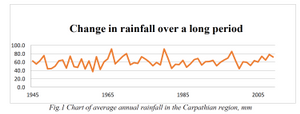
Over the past 70 years, rainfall has increased by an average of 8.4 mm. The average annual precipitation begins to increase, especially after 1995.
The most significant amount of precipitation usually falls in July, the smallest in January. Average rainfall during the winter period in the investigated region is within the range of 30-35 mm. However, marked years with much more rainfall during the winter period are, for example, 1948, 1965, 1995, 1999, 2014.
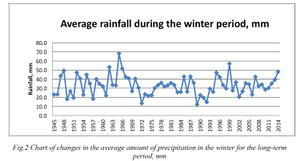
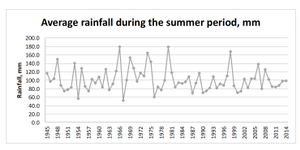
The average amount of precipitation dropped in the summer has significant volatility during the specified period, and there are a lot of extreme low and high values.
The highest amount of precipitation is the average in the summer, in the studied time interval fell in 1978 and was 178.7 mm.
The smallest - in 1967, it was 51.8 mm, this year also recorded high temperature data for the summer.
2.2. Relationship between solar cycles and changes in average rainfall
Solar activity undoubtedly affects the temperature regime of the region. The years of minimum 11-year solar cycles that were traced to the beginning of the 21st century completely coincide with the years with the smallest average annual temperature in the studied region (1954, 1964, 1976, 1986, 1996).
In addition, solar cycles also affect the amount of precipitation [2].
To study the influence of solar cycles on rainfall, a time interval was chosen from 1944 to 2009. It was in 1944 that the eighteenth solar cycle began. Data on average rainfall collected from hydrometeorological stations in the Carpathian region were grouped at time intervals corresponding to 11 years of solar cycles. The average values of rainfall in the winter, spring, summer and autumn periods in these solar cycles were then calculated. The results are presented in Table 1.
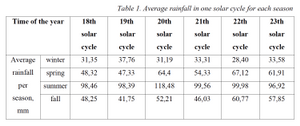
Let's show this analysis on the example of the winter time in the form of a table.

Indicators of average rainfall during the spring, summer and autumn periods behave directly against the winter indicators, but the same cyclicality of these changes has been noted: in the 19th solar cycle, the decrease in the average rainfall, as compared to the 18th cycle, in the 20th year is an increase, a decrease of 21, an increase in 22 and again decrease in the 23rd solar cycle.

We group the change in the amount of precipitation for the investigated time interval into two groups for so-called, for "pair" and "odd" solar cycles. And we will conduct a study of the change in the amount of precipitation in the long run separately for "pair" and "odd" solar cycles. So in the end, we can more accurately estimate the change in rainfall in each of the seasons.
Let's make a forecast for future changes in the amount of precipitation in the autumn period, taking into account the solar cycles. As a result, we obtain an exponential dependence, the magnitude of the reliability of the approximation is 0.97, the correlation coefficient is 0.98. Performing similar calculations for the average precipitation in "odd" solar cycles, we make a forecast for future changes in the average rainfall during the autumn period. The results are presented in the table 4.
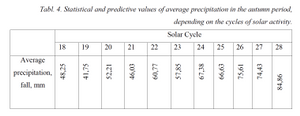
Conclusions
In this work, the analysis of rainfall changes in the region was carried out both in the average yearly and separately in each season. It can be noted that these changes have different trends in each case. For example, the amount of precipitation falling in the summer has a significant amount of extreme values in the period under study.
The average annual rainfall of particularly intensive began to increase after 1995.
The study of the relationship between rainfall changes and solar cycles has shown that solar cycles affect the seasonal change in rainfall.
Thus, the distribution of seasonal rainfall in solar cycles over the study period in this region made it possible to more accurately and precisely estimate the change in this parameter and could be used for a more accurate forecast of rainfall changes in the region.
Also, this approach can be used to study changes in rainfall in other regions.
References
[1] “Solar activity.” - [Electronic resource] - Resource access mode: https://uk.wikipedia.org/wiki/Сонячна_активність.
[2] “Climate Change 2013: The Physical Science Basis.” - Cambridge University Press. – 2014.
[3] “Climate Change 2014: Mitigation of Climate Change.” - Cambridge University Press. – 2015.
[4] “Climate Change 2014: Synthesis Report.” - IPCC. – 2015
[5] “Climate phenomena and their relevance for future regional climate change.” [Electronic resource] - Resource access mode:http://www.climatechange2013.org/images/report/WG1AR5_Chapter14_FN AL.pdf.
[6] ESSEA [Electronic resource] - Resource access mode: https://esseacourses.strategies.org.
[7] “Global Climate Change.” - [Electronic resource] - Resource access mode: https://climate.nasa.gov.
[8] Harrison R. M. “Climate change.” In: Harrison, R. M. (ed.) - “Pollution : causes, effects and control.” - Royal Society of Chemistry, London. – №5. – С. 326–339.
[9] “Intergovernmental Panel on Climate. Climate Change 2014 – Impacts, Adaptation and Vulnerability: Regional Aspects.” - Intergovernmental Panel on Climate. - 2015. https://doi.org/10.1017/CBO9781107415416.020
[10] Ismailova O., Voloshkina O. “Analysis of the impact of solar activity on indicators of climate change on areas within the Dniester river basin.” - Ekolohichna bezpeka ta pryrodokorystuvannya. – 2016. – С. 51–57.
[11] “Long-term climate change: Projections, commitments and irreversibility.” - [Electronic resource] - Resource access mode: http://pure.iiasa.ac.at/10551/.
[12] NOAA. - Climat.gov. - [Electronic resource] - Resource access mode: https://www.climate.gov/
[13] D.Varavin “Complex analysis of legal documents for ensuring the environmental safety of the reconstruction objects of the housing sector of Ukraine and the leading countries of the world.” USEFUL online journal, vol. 1, no. 1, pp. 43–51, September 2017. https://doi.org/10.32557/useful-1-1- 2017-0005
Please cite as: O. Ismailova, O.Voloshkina “Improvement of analysis of seasonal change of danger risk with consideration of the effect of solar cycle.” USEFUL online journal, vol. 1, no. 2, pp. 11–18, December 2017. DOI: https://doi.org/10.32557/useful-1-2-2017-0002








Comments